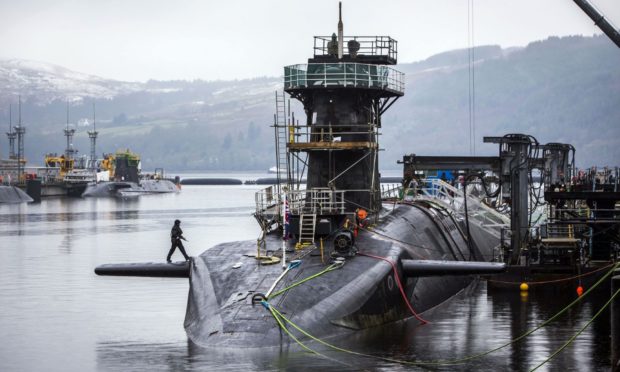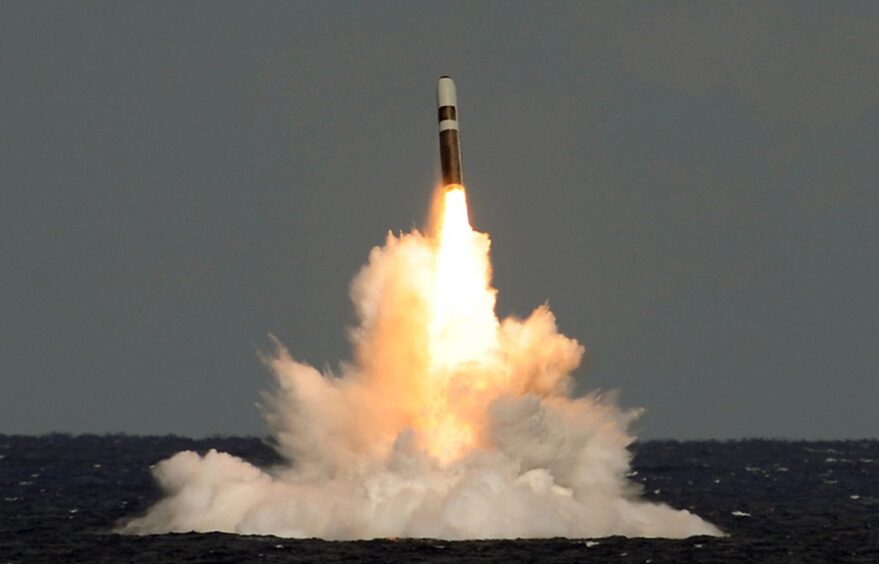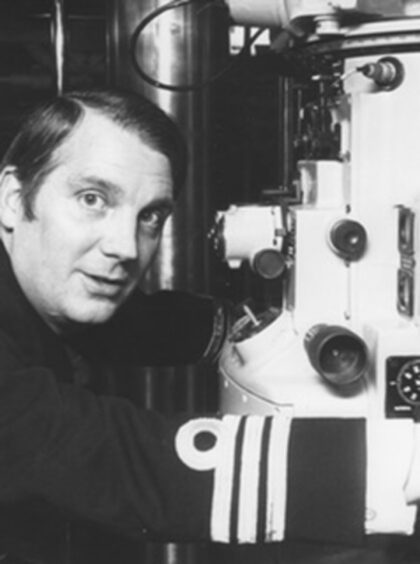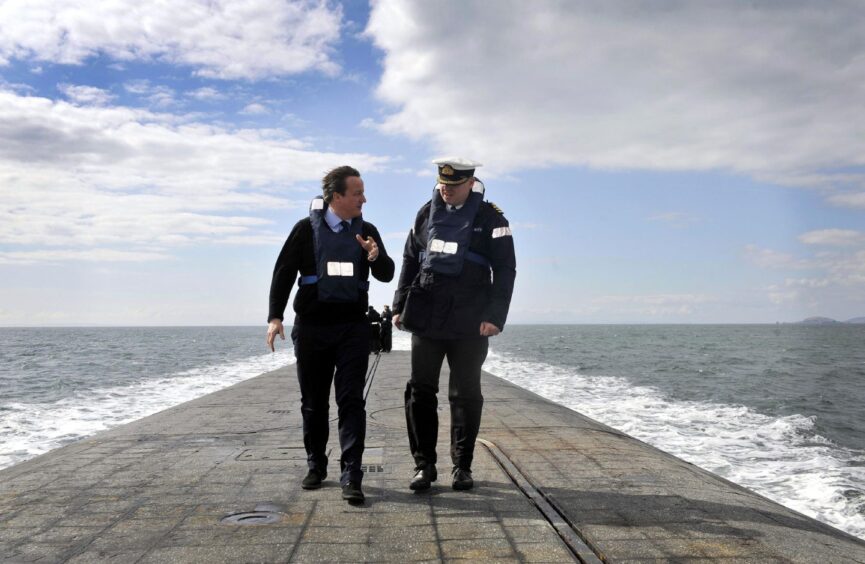
Covered in rust and missing sections of the anti-sonar tiling which lines its exterior, HMS Vengeance docked at Faslane last month after a gruelling 201 days on patrol.
It is the second time a Vanguard-class submarine has undergone a tour exceeding six months after HMS Vigilant returned from a record-breaking stint at sea in September.
Campaigners describe it as the dangerous new normal, with an ageing fleet necessitating increasingly long patrols that put a physical strain on the vessels and take a psychological toll on crews.
In a series of interviews with The Sunday Post, submariners and military experts warn of the growing risk of a catastrophic accident onboard Britain’s nuclear deterrent.
We reveal how parts are being cannibalised from other submarines to keep the fleet afloat and how, on one particularly long recent deployment, food stores began to run out as workers waited for a replacement vessel to be ready.
What makes up the nuclear deterrent?
The UK has four Vanguard-class submarines, which are armed with up to eight Trident ballistic missiles carrying nuclear warheads. At least one submarine is on patrol at all times to maintain a continuous at-sea deterrent.
Lengthy maintenance work saw the fleet reduced to just two functioning vessels, HMS Vigilant and HMS Vengeance, until HMS Vanguard returned to service in October.
That ended in embarrassment in January after a ballistic missile failed to launch from Vanguard during a test of its capabilities.
Patrols have grown to almost double the duration seen in previous generations to cover for the repairs and campaigners say the strain is putting lives at risk.
A crew of 140 was saved moments from disaster late last year as it sank towards dangerous depths because of a technical fault.
A malfunction with the depth gauge meant the vessel was unknowingly moving towards crush depth – the point at which the pressure on the submarine could cause it to implode – before engineers spotted the mistake.
“My generation find the concept of six months almost unbelievable.”
Retired navy commander Rob Forsyth
Retired navy commander Rob Forsyth believes the longer patrols have resulted an increased safety risk.
He warned greater pressure on ageing equipment coupled with the psychological strain on crew members could lead to disaster.
Forsyth told us: “All the boats are past their design life now which means they are more liable to technical failure.
“I was at sea in Polaris boats and we used to reckon three months was the longest for keeping your sanity.
“My generation find the concept of six months almost unbelievable. It must be having an effect on at least some of the people.
“I believe there will be some form of lasting mental damage.”
Forsyth captained the nuclear-powered but conventionally-armed hunter-killer submarine HMS Sceptre from 1977-79.
He retired from the Royal Navy in 1980 to pursue a career in industry.
Forsyth, who now campaigns against Trident, said the UK is approaching the stage of having to ask whether it is possible to maintain a continuous deterrent.
With a new generation of submarines not expected to become operational until at least the early 2030s, he said the price being paid is “putting both boats and people at risk”.
Why are patrols getting longer?
One of the reasons deployments have been so long is because of difficulties getting relief vessels ready to deploy.
HMS Vengeance was supposed to be relieved by Vigilant but the process of getting that boat ready for duty faced continual problems, meaning it was months late.
For crews on board that means weeks longer spent in cramped and difficult conditions with no clear idea of when they will be able to return to family and friends.
Patrols often mean working without days off, showering for 20 seconds every two days and communication from home coming via a 120-word correspondence received once a week.
The Sunday Post has learned on one recent deployment the crew began to run out of food while waiting to be relieved by another vessel.
One submariner, who asked not be named, said recruiters are not being honest with people about the length of tours and conditions they could face.
They told us they fear the whole programme could grind to a halt with “so many” people signed off sick for mental health reasons.
Defence experts alarmed
On top of growing questions about morale and conditions on board, defence experts have questioned whether the Vanguard-class vessels will be able to stay in service long enough for a handover to the next generation – even with longer patrols.
Analyst Francis Tusa warned they could “fall off a cliff” long before then.
The submarines were only designed to last 25 years but will be almost 40 years old by the time they are replaced by the Dreadnought class early in the next decade.
“At this point there is little they can do to radically accelerate the construction of the Dreadnoughts.”
Matthew Savill, director of military sciences at the Royal United Services Institute
A 2006 government report noted even with efforts to extend the life of the vessels, the first was expected to go out of service in 2022 and the second in 2024.
It stated: “Continuous deterrent patrols could no longer be assured from around this latter point if no replacement were in place by then.
“Any further extension of the life of the submarines would mean that the key components described previously would need to be replaced or refurbished, and this would require a major refit of the submarines.
“This would not extend the lives of the submarines much further and would not therefore be cost effective.”
But in 2010, the government – led by David Cameron, the current foreign secretary – delayed approval by a further five years until 2016.
If Dreadnought’s construction had begun around 2011, as originally intended, it would now be just a year or two away from coming into service.
‘Not much can be done now’
Matthew Savill, director of military sciences at the Royal United Services Institute, said current issues are the consequence of years of incremental delays in both policy and engineering challenges with the fleet.
He said: “I’m not sure if there is anything that can be done now.
“At this point there is little they can do to radically accelerate the construction of the Dreadnoughts.
“So the questions becomes whether there’s a way they can manage the existing infrastructure of the submarines and support the crews.
“I suspect that is where the more of the efforts will go, trying to maintain the state of the submarines so 200 day patrols are anomalous rather than the norm.”
The Sunday Post put all of these concerns to the Royal Navy. In response, it reissued a stock comment it has been using for months on long deployments.
The response states: “Our continuous at sea deterrent protects us and our NATO Allies every moment of every day.
“We are immensely grateful to the submariners onboard, and their loved ones, for their commitment and dedication.
“While we do not comment on patrol lengths, we take safety very seriously and all submarines go through rigorous safety checks before any patrol.”

Enjoy the convenience of having The Sunday Post delivered as a digital ePaper straight to your smartphone, tablet or computer.
Subscribe for only £5.49 a month and enjoy all the benefits of the printed paper as a digital replica.
Subscribe




